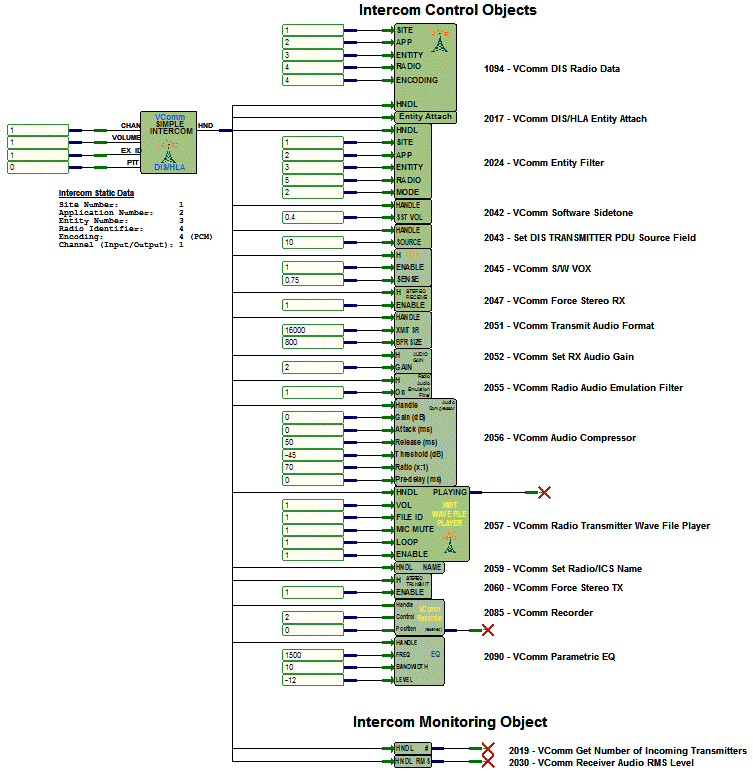|
|
VComm Simple Intercom (DIS/HLA) |
|
ID: 2032 |
|
|
VComm Simple Intercom (DIS/HLA) |
|
ID: 2032 |
|
Object Description |
|||||||||
|
The VComm Simple Intercom (DIS/HLA) object employs the Radio Communications protocol of the Distributed Interactive Simulation (DIS) standard (refer to the IEEE standards 1278.1a-1995, 1278.1a-1998, and 1278.1a-2xxx). This intercom has input pins to control the basic functionality of a full-duplex networked intercom. However, an output pin provides a handle for the intercom which can be used by several other VComm objects to enhance the run-time control of the object. Note: Attachable objects require additional processing. It is advisable to only use attachable objects if they are needed in a given design. This intercom is essentially a VComm GENERIC Radio with the following fixed attributes:
For more information, refer to the VComm User Manual. |
|||||||||
|
Input Pins |
|||||||||
|
CHAN |
The CHAN pin accepts a floating point number which is treated as an integer with any fractional parts truncated. Range: 0 to 3000. | ||||||||
|
VOLUME |
The VOLume pin accepts a floating point number which is used to adjust the volume of the intercomm heard at the headsets. Range: 0.0 to 1.0. | ||||||||
|
EX ID |
The EX ID pin accepts any floating point number which is treated as an integer with any fractional parts truncated. It represents the DIS Exercise ID. Range: 0 to 255. | ||||||||
|
PTT |
The PTT pin acts as the Push-To-Talk switch for intercomm transmissions. Any non-zero value engages transmission; a value of 0 does not. | ||||||||
|
Output Pin |
| ||||||||
|
HND |
The HND output pin provides a unique intercomm handle for this object for use by other objects (see below). | ||||||||
|
Static Data |
|||||||||
|
Site Number Application Number Entity Number Radio Identifier |
These four single precision floating point values create a unique Entity Identifier for this radio on a DIS network. The DIS specification requires that each entity participating in a DIS exercise must have a unique site/app/entity identifier. The radio ID is provided to distinguish between multiple radios attached to a single entity (see IEEE 1278.1 DIS standard for details). V+ interprets each of the values as a 16 bit unsigned number, so only whole numbers between 1 and 65534 are valid.
If you do not need to set specific Entity Identifier for your radios, simply leave the site/app/entity/radio numbers at zero. VComm can create an automatic Entity Identifier for radios if the radio is not attached to an object that sets IDs, and if Site Number, Application Number (Host ID) or Entity Number is set to zero at startup. In this case, the computers IP address is used to establish an Entity Identifier. A computer IP address is divided into four fields called octets. VComm uses the third octet (left to right numbering) to set the Site Number and the fourth octet to set the Application Number. The Entity Number is set to one, and the Radio Identifier is set automatically based on the execution sequence (order of creation) of the radio in V+. For example, if a machine has an IP address of 192.168.1.200, the radio’s Entity Identifier would be as follows:
| ||||||||
|
Encoding |
This parameter defines the way the signal packets are encoded before being sent over the network. The following values are valid for this parameter: 1 - µ-Law (pronounced Mew-Law), 2:1 compression 2 - CVSD per MIL-STD 188-113, 16:1 compression 3 - ADPCM per CCITT G7.21, 4:1 compression 4 - 16 bit PCM (Big Endian), 1:1 compression 5 - 8-bit Linear PCM, 1:1 compression 6 - VQ (Vector Quantization), Variable compression, (Not Supported in VComm) 7 - CVSD CCTT (bit reversed), 16:1 compression 8 - 1.625-bit GSM 06.10, Variable compression, (Currently in development in VComm) 9 - 0.7 bit GSM Half Rate 06.20, Variable compression, (Currently in development in VComm) 100 - 16-bit Linear PCM (Little Endian), 1:1 compression 255 - CVSD, 16:1 compression
This parameter only affects signal transmissions. Received signal packets will be properly decoded based on the transmitted encoding scheme, regardless of the setting of this parameter. Note: The Encoding value may be changed dynamically while V+ is running and will take effect without having to stop and start V+. | ||||||||
|
Channel (Input/Output) |
This parameter designates which sound device input/output channel pair is to be used for the analog input and analog output during transmission and reception of digital voice streams. If using an SMx system, this number is the Wave In channel for the input stream (microphone), and its corresponding Wave Out channel for the output stream (headphones). More about Devices and Channels:
| ||||||||
|
Send To |
Determines how the radio communicates on the network. This parameter is a bit mask which is a combination of four distinct modes: DIS Primary Network, DIS Secondary Network, DIS Loopback, and HLA. Internally, each of these modes is represented by a separate bit, which can be combined to form unique values. The following are the only recognized values for this static datum: 1.0 - DIS Primary Network only 2.0 - DIS Secondary Network only 3.0 - DIS Primary and Secondary Networks 4.0 - DIS Loopback 8.0 - HLA only 9.0 - DIS Primary Network and HLA 10.0 - DIS Secondary Network and HLA 11.0 - DIS Primary and Secondary Networks and HLA 12.0 - DIS Loopback and HLA
For more information on network modes and how to configure them, refer to the VComm User's Manual. | ||||||||
|
VComm Intercom Control Objects |
|||||||||
|
|
|||||||||
|
VComm Intercom Monitoring Object |
|||||||||
|
Example |
|||||||||
|
The following example demonstrates the use of the VComm Simple Intercom object. |
|||||||||
